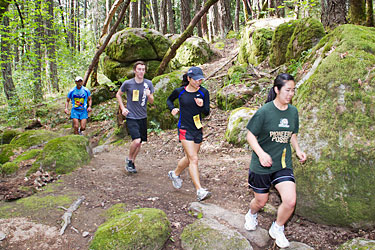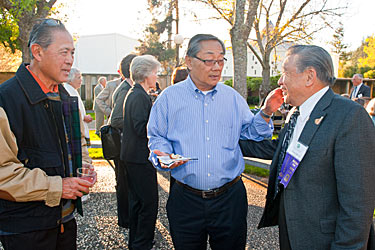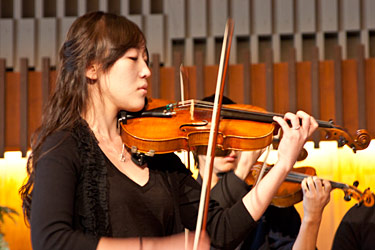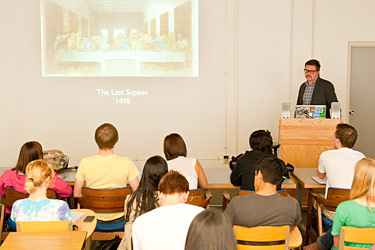Learn More About PUC
Archives

REVO Race Benefits ADRA Project
Posted by Larry Peña on April 20, 2011
REVO PUC, the college’s popular student-run philanthropy organization, raised over $1,800 toward a community kitchen at a charity run Sunday, April 17. The race, which took runners through 3.1 miles of PUC’s beautiful forest trails, was the kickoff event for REVO’s annual fundraising season and also served as the capstone event of PUC’s Homecoming Weekend. Approximately 100 runners—including students, alumni, and local athletes— participated in the race. Their $30 entrance fees will go to Adventist Development and Relief Agency, which is partnering with REVO to establish a self-sufficient community kitchen serving Argentina’s underdeveloped province of Salta. Napa Valley local Alex Lovick won first place in the race. In 2008 PUC students started the first campus branch of REVO, an international philanthropy movement. The students, who are entirely responsible for the project, select a different cause each year to support with fundraising and awareness events. Hundreds of students on campus get involved each year—through planning, coordinating, event participation, or donations. Causes have included rehabilitating the victims of human trafficking in Peru, supporting local food banks, and combating a debilitating disease rampant in Ethiopia....

Homecoming 2011: This Mountain Brought Us Together
Posted by Larry Peña on April 19, 2011
Pacific Union College alumni returned to the mountain as the college held its annual Homecoming Weekend under sunny skies, April 15-17. This year’s program honored the graduating classes of ’41, ’51, ’61, ’71, ’81, ’91, ’01, and ’06, plus 25-year reunion class of ‘86. The celebration began Friday evening with the traditional Diogenes Dinner, a banquet honoring a person who has shown outstanding lifelong service to PUC. This year’s honorees were Ruth and Lyle McCoy, ’42 and ’45, two local alumni who have been intimately involved with the Angwin community and have given regularly and substantially in support of the college. President Heather J. Knight recognized the iconic PUC couple with another PUC icon—a beautiful watercolor painting of the old west wing of Irwin Hall by former art professor Vernon Nye. Knight took the opportunity to announce her dream of restoring that historic structure, which was demolished in 1982 amid concerns of its structural integrity. The announcement drew pronounced applause from the attendees, as Irwin Hall has long been a rallying point for many of PUC’s alumni. Following a short service honoring alumni who have passed away this year, Brigadier General Loree K. Sutton, M.D., ’81, presented the message at...

Cortes Joins PUC as Campus Chaplain
Posted by Larry Peña on April 14, 2011
Pastor Laffit Cortes has accepted the position of PUC campus chaplain and associate pastor of the PUC Church, and will begin the new post effective July 1 of this year. Cortes currently serves as the youth director for the New Jersey region of the Seventh-day Adventist Church, and comes with a wealth of outreach and young adult ministry experience that makes him an ideal fit for the position. As youth director, Cortes coordinates ministry events and programs for young people within the 13,000-member New Jersey Seventh-day Adventist community. He has also been a featured speaker at a variety of programs for young people within New Jersey and across the country. Cortes began laying the groundwork for his ministry at PUC April 7, when he came to Angwin to meet with student leaders and administrators on campus to begin planning for next school year. He will also took the opportunity to meet and greet the campus April 8 at a special program for PUC students. “I hope to collaborate with others as we develop future servant leaders that will not only love God, but live lives dedicated to serving as Christ did,” he says. “By God's grace, He will use us...

PUC Celebrates Diversity With Asian-American Colloquy
Posted by Eirene-Gin Nakamura on April 8, 2011
In the tradition of celebrating the diversity of its student body, Pacific Union College recognized its Asian-American students at colloquy Thursday morning. The Asian-American heritage colloquy shed light on the culture and talents of the students who comprise roughly 23 percent of the total student body. This was the fourth in a series of assemblies putting the spotlight on the various ethnic groups with a strong presence on campus. A number of Asian-American students displayed their talents through musical performances throughout the meeting. Peter Han, a junior film and biology major, conducted an Asian-American string ensemble, who played Antonio Vivaldi’s “Spring: Allegro” from The Four Seasons violin concerto. Junior Carissa Kan and sophomore Ernest Ly later sang a Chinese song entitled, “Mei Li De Shen Hua.” The colloquy featured chemistry professor Ray Rajagukguk as speaker, who spoke on the role Asian-American Christians should play as members of the “model minority”—a term in social psychology used to describe a minority group (typically Asian American) who achieves greater success than their society’s average. Focusing on the empowerment brought about by the emphasis on education in Asian-American culture, Rajagukguk called students to use their education with the intent of imparting that knowledge others....

Students Participate in Innovative Art Education
Posted by Katelynn Christensen and Larry Peña on April 7, 2011
College students have long felt the burden of textbooks—their weight, price tag, and time consumption. Since last spring, Pacific Union College art history professor Alexander Carpenter has simplified the lives of his students by integrating Smarthistory.org, a non-profit, multimedia art history “web-book,” into his lesson plans. This web resource combines the text and images of traditional textbooks with new features, like discussion video clips, to dynamically and engagingly supplement—or even replace—art survey course textbooks. Now PUC students have gotten involved with the project directly, making their own impact on this increasingly popular web resource. Smarthistory.org and the classroom meet as Carpenter requires students to watch the site’s discussion video clips and respond to a number of questions in preparation for upcoming lectures. “I’ve noticed that students seem to come to class better prepared,” he says. “[And] I think the questions are more engaging than what I had [students answering] before.” Carpenter enjoys the flexibility offered by the website because he does not believe students retain information from long reading assignments as well as they could from multimedia sources. “As a student, I really didn’t like when teachers would assign a lot of [reading] because I felt like I didn’t know...
